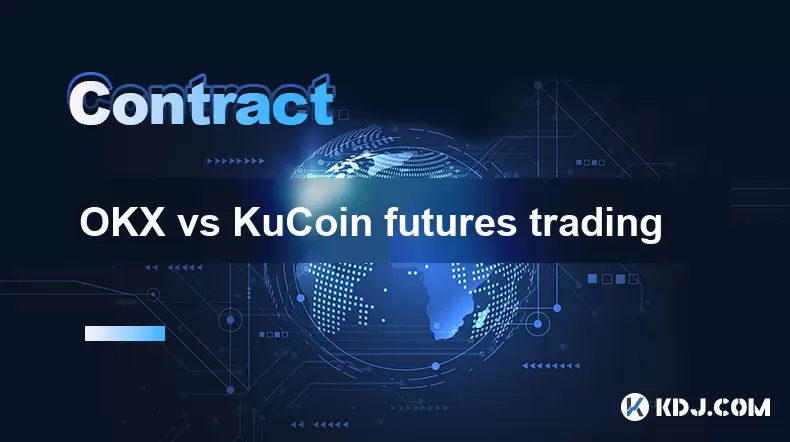-
 Bitcoin
Bitcoin $119300
1.07% -
 Ethereum
Ethereum $3730
3.87% -
 XRP
XRP $3.235
0.29% -
 Tether USDt
Tether USDt $1.000
0.00% -
 BNB
BNB $783.5
1.88% -
 Solana
Solana $188.7
0.25% -
 USDC
USDC $0.0000
-0.01% -
 Dogecoin
Dogecoin $0.2399
-0.44% -
 TRON
TRON $0.3157
2.37% -
 Cardano
Cardano $0.8254
1.94% -
 Hyperliquid
Hyperliquid $42.83
0.14% -
 Stellar
Stellar $0.4372
3.21% -
 Sui
Sui $3.859
4.91% -
 Chainlink
Chainlink $18.53
3.53% -
 Hedera
Hedera $0.2464
0.01% -
 Bitcoin Cash
Bitcoin Cash $519.8
2.46% -
 Avalanche
Avalanche $24.24
2.17% -
 Litecoin
Litecoin $113.7
0.73% -
 UNUS SED LEO
UNUS SED LEO $8.990
0.30% -
 Shiba Inu
Shiba Inu $0.00001390
0.21% -
 Toncoin
Toncoin $3.188
1.49% -
 Ethena USDe
Ethena USDe $1.001
0.02% -
 Polkadot
Polkadot $4.090
-0.91% -
 Uniswap
Uniswap $10.40
4.08% -
 Monero
Monero $326.6
3.12% -
 Bitget Token
Bitget Token $4.627
-0.42% -
 Pepe
Pepe $0.00001281
0.76% -
 Dai
Dai $1.000
0.01% -
 Aave
Aave $291.6
0.98% -
 Cronos
Cronos $0.1269
7.26%
OKX vs KuCoin futures trading
OKX and KuCoin offer competitive crypto futures trading with up to 100x leverage, low fees, and diverse assets, but differ in interface, tools, and contract flexibility.
Jul 21, 2025 at 11:42 pm

Understanding Futures Trading Platforms
Futures trading has become a popular method for cryptocurrency traders to speculate on price movements without owning the underlying asset. Platforms like OKX and KuCoin offer futures trading services, each with unique features that cater to different user preferences. To make an informed decision, it's essential to compare the key aspects of these platforms, including leverage options, trading fees, available cryptocurrencies, and user interface.
Leverage is a critical factor in futures trading, allowing traders to amplify their potential gains (and losses). OKX offers up to 100x leverage on certain pairs, while KuCoin provides up to 100x leverage as well, but with some restrictions based on the trader's account tier and the specific cryptocurrency pair being traded. Traders should carefully assess their risk tolerance before using high leverage.
Trading Fees and Funding Rates
Trading fees play a significant role in determining the profitability of futures trading. Both OKX and KuCoin use a maker-taker fee structure, which rewards users who add liquidity to the market (makers) and charges those who remove liquidity (takers).
OKX employs a tiered fee system based on 30-day trading volume and OKB holdings. Maker fees start at -0.010%, and taker fees begin at 0.020%. In contrast, KuCoin offers maker fees starting at 0.00% and taker fees starting at 0.02%. Both platforms provide fee discounts for users holding their native tokens (OKB for OKX and KCS for KuCoin).
Funding rates are another crucial aspect of perpetual futures contracts. These rates are exchanged between long and short positions every 8 hours to ensure that the contract price aligns with the spot price. OKX and KuCoin both use dynamic funding rates, which are determined by market conditions. Traders should monitor these rates regularly, as they can significantly impact holding costs over time.
User Interface and Trading Tools
The user interface and available trading tools can greatly influence a trader's experience. OKX is known for its advanced trading interface, which includes detailed charting tools, risk management features, and customizable layouts. It caters well to experienced traders who require in-depth analytics.
KuCoin, on the other hand, offers a more user-friendly interface that is suitable for both beginners and intermediate traders. The platform provides a clean layout with easy-to-navigate menus and a straightforward order placement system. However, it lacks some of the advanced features found on OKX, such as sophisticated risk management tools and detailed position tracking.
Both platforms offer mobile applications for on-the-go trading, but OKX’s app is generally considered more feature-rich, especially for futures traders. KuCoin’s mobile app is intuitive and user-friendly but may not be as robust for advanced futures trading strategies.
Available Cryptocurrencies and Contract Types
The variety of cryptocurrencies and contract types available for futures trading is another important consideration. OKX supports a wide range of cryptocurrencies, including major ones like Bitcoin (BTC), Ethereum (ETH), and Solana (SOL), along with numerous altcoins. It offers both quarterly futures and perpetual contracts.
KuCoin also provides a diverse selection of cryptocurrencies for futures trading, though slightly fewer than OKX. It offers perpetual contracts and inverse futures for popular assets. Users should check which platform supports the specific cryptocurrency they are interested in trading.
In terms of contract types, both platforms offer perpetual contracts, which are the most commonly traded futures instruments in the crypto space. However, OKX provides more flexibility with its quarterly futures contracts, which may appeal to traders with specific time-based strategies.
Security and Reliability
Security is a top priority for any cryptocurrency exchange, especially for futures trading, where large positions can be affected by platform stability. OKX has a strong track record of security and has implemented multiple layers of protection, including cold storage for funds, two-factor authentication (2FA), and regular security audits.
KuCoin has also taken significant steps to enhance security, particularly after a major hack in 2020. The platform now uses advanced encryption, multi-signature wallets, and a dedicated security team to monitor and respond to threats. Both exchanges offer insurance funds to cover potential losses from liquidations.
Reliability in terms of uptime and order execution is crucial for futures traders. OKX generally maintains high uptime and fast order execution, even during periods of high volatility. KuCoin has improved its infrastructure in recent years and offers comparable performance, though some users report occasional delays during extreme market conditions.
Step-by-Step Guide to Setting Up Futures Trading on OKX and KuCoin
Setting up a futures trading account on either OKX or KuCoin involves several key steps. Below is a detailed guide for both platforms:
- Register for an account on OKX or KuCoin by providing an email address and creating a strong password.
- Complete the KYC (Know Your Customer) verification process, which may include submitting identification documents.
- Deposit funds into your account. Both platforms support deposits in various cryptocurrencies and, in some cases, fiat currencies.
- Navigate to the futures trading section. On OKX, this can be found under the "Trade" menu, while on KuCoin, it is accessible from the main dashboard.
- Select the desired cryptocurrency pair and contract type (perpetual or quarterly).
- Set up leverage by adjusting the leverage slider or entering a custom value.
- Place a long or short order using either a market order or a limit order, depending on your trading strategy.
- Monitor your position and set stop-loss and take-profit levels to manage risk effectively.
Users should also familiarize themselves with the margin requirements and liquidation prices associated with their positions to avoid unexpected losses.
Frequently Asked Questions
Q: Can I trade futures on both OKX and KuCoin without KYC?
A: While both platforms allow limited trading without KYC, futures trading typically requires full account verification due to regulatory requirements and higher risk exposure.
Q: How do OKX and KuCoin handle liquidations in futures trading?
A: Both platforms use a liquidation engine to automatically close positions when the margin is insufficient. OKX employs an insurance fund to cover losses from deep liquidations, while KuCoin uses a similar mechanism to protect traders from negative balances.
Q: Are there demo accounts available for futures trading on OKX and KuCoin?
A: Yes, both platforms offer paper trading or demo modes that allow users to practice futures trading without risking real funds.
Q: What are the differences in margin types between OKX and KuCoin?
A: OKX allows users to choose between isolated and cross-margin modes, offering more flexibility. KuCoin also supports both margin types but may have different default settings depending on the contract.
Disclaimer:info@kdj.com
The information provided is not trading advice. kdj.com does not assume any responsibility for any investments made based on the information provided in this article. Cryptocurrencies are highly volatile and it is highly recommended that you invest with caution after thorough research!
If you believe that the content used on this website infringes your copyright, please contact us immediately (info@kdj.com) and we will delete it promptly.
- Bitcoin, Jim Cramer, and the US Deficit: A Wall Street Story
- 2025-07-25 10:30:11
- TGEs, Scalability & Privacy Tech: Decoding the Future of Blockchain
- 2025-07-25 10:30:11
- Ben Askren, FUNKY Memecoin, and the Fallout: A New York Minute
- 2025-07-25 10:50:11
- TRON, Crypto Payroll, and Stablecoins: A New York Minute on the Future of Finance
- 2025-07-25 08:30:11
- WazirX, Revote, and Crypto Unlock: A New York Minute on the Latest Developments
- 2025-07-25 06:50:11
- Hong Kong Stablecoin Regulation: Navigating the Hype and Hurdles
- 2025-07-25 08:30:11
Related knowledge

Why is my Bitstamp futures position being liquidated?
Jul 23,2025 at 11:08am
Understanding Futures Liquidation on BitstampFutures trading on Bitstamp involves borrowing funds to open leveraged positions, which amplifies both po...

Does Bitstamp offer inverse contracts?
Jul 23,2025 at 01:28pm
Understanding Inverse Contracts in Cryptocurrency TradingIn the realm of cryptocurrency derivatives, inverse contracts are a specific type of futures ...

How to find your Bitstamp futures trade history?
Jul 23,2025 at 08:07am
Understanding Bitstamp and Futures Trading AvailabilityAs of the current state of Bitstamp’s service offerings, it is critical to clarify that Bitstam...

Can I use a trailing stop on Bitstamp futures?
Jul 23,2025 at 01:42pm
Understanding Trailing Stops in Cryptocurrency TradingA trailing stop is a dynamic type of stop-loss order that adjusts automatically as the price of ...

Can I use a trailing stop on Bitstamp futures?
Jul 25,2025 at 02:28am
Understanding Trailing Stops in Cryptocurrency Futures TradingA trailing stop is a dynamic type of stop-loss order that adjusts automatically as the m...

What are the trading hours for Bitstamp contracts?
Jul 24,2025 at 11:56am
Understanding Bitstamp and Contract Trading AvailabilityBitstamp is one of the longest-standing cryptocurrency exchanges, established in 2011 and head...

Why is my Bitstamp futures position being liquidated?
Jul 23,2025 at 11:08am
Understanding Futures Liquidation on BitstampFutures trading on Bitstamp involves borrowing funds to open leveraged positions, which amplifies both po...

Does Bitstamp offer inverse contracts?
Jul 23,2025 at 01:28pm
Understanding Inverse Contracts in Cryptocurrency TradingIn the realm of cryptocurrency derivatives, inverse contracts are a specific type of futures ...

How to find your Bitstamp futures trade history?
Jul 23,2025 at 08:07am
Understanding Bitstamp and Futures Trading AvailabilityAs of the current state of Bitstamp’s service offerings, it is critical to clarify that Bitstam...

Can I use a trailing stop on Bitstamp futures?
Jul 23,2025 at 01:42pm
Understanding Trailing Stops in Cryptocurrency TradingA trailing stop is a dynamic type of stop-loss order that adjusts automatically as the price of ...

Can I use a trailing stop on Bitstamp futures?
Jul 25,2025 at 02:28am
Understanding Trailing Stops in Cryptocurrency Futures TradingA trailing stop is a dynamic type of stop-loss order that adjusts automatically as the m...

What are the trading hours for Bitstamp contracts?
Jul 24,2025 at 11:56am
Understanding Bitstamp and Contract Trading AvailabilityBitstamp is one of the longest-standing cryptocurrency exchanges, established in 2011 and head...
See all articles

























































































